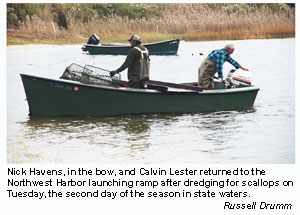Some Hope for Scallops

Each year since 1985, when a series of brown algae blooms devastated the East End scallop population, the opening day of scallop season has dawned with a mixture of hope and frustration. While it is still too early to tell - scallopers only began towing their dredges in state waters on Monday - experts point to signs that could indicate the slow rebirth of the valuable fishery.
In an effort to permit slower-growing scallops a chance to have a fall spawn, both the State Department of Environmental Conservation and East End townships have delayed, by a month, the opening of this year's scallop season in the waters they manage. The scallop season in East Hampton, Southampton, and Southold will begin on Nov. 21.
November replaced October despite the fact that whatever scallops are harvested will compete with the November opening of beds in Nantucket and Martha's Vineyard. A small area on Cape Cod opened on Oct. 20, the rest of the Cape on Monday.
Stuart's Seafood in Amagansett and the Seafood Shop in Wainscott buy most of the local scallop production. On Tuesday, Bruce Sasso, Stuart's owner, explained the tricky science of buying and selling the shellfish that now enjoys seafood's equivalent of a cult following.
He said that because scallops are scarce, and because the price for Cape Cod scallops opened lower than expected, buyers are caught between the need to keep baymen happy (by not shopping for their product elsewhere), and the spending limits of their consumers.
"We're paying more than Cape Cod," Mr. Sasso said, and more than Southampton's primary buyer, the Cor-J shop. He went on to predict that the retail price would run between $20 and $22 per pound, depending on weather and other variables.
Mr. Sasso said the season would probably get off to a good start, but that the harvest would probably dwindle in a month's time, as it did last year. Last season, Lake Montauk seemed to have been the most productive area, although the harvest was still very small when compared to pre-algae days.
Greg Rivara, a scallop specialist with the Cornell Cooperative Extension, reported that some baymen were able to get their 10 bushel limit - 20 per boat with two baymen fishing - around Robbins Island on Monday.
Calvin Lester and Nick Havens pulled their boat up to the Northwest Harbor launching area at about 11:30 on Tuesday morning after working the southeast part of the harbor for about three hours. The baymen had only five bushels between them.
"There's no grass. It doesn't take a rocket scientist. There's no grass to hold the bugs. They blow ashore," Mr. Lester said. The scarcity of the scallops' eelgrass habitat is one explanation for the failure of scallops to return to one of the most productive beds on the entire East Coast. In 1984, the year before the brown tide descended on the East End, 278,532 pounds of scallop meats were harvested from the Peconic Estuary according to the D.E.C. Fewer than 2,000 pounds were shucked in 2002, with little increase since then.
"There used to be 150 boats in here. You'd be done by 9, but at noon you could still find 40 in a dredge," Mr. Lester said, recalling the season's opening days before the brown blooms.
It isn't only the eelgrass shortage. Steve Tettlebach, a professor of marine science at Southampton College, and others, have theorized that a low population of widely-scattered scallops cannot produce enough fertilized spawn to resurrect the population.
As a result, the Bay Scallop Spawner Sanctuary Evaluation Project was created last year in cooperation with the state D.E.C., the Nature Conservancy, Southampton College, and Cornell Cooperative Extension. The project is supported by a $150,000 grant from the U.S. Fish and Wildlife Service, through the state's wildlife grant program.
Bug scallops from the East Hampton and Southold hatcheries were placed in a small area on the east side of Northwest Harbor and in other East End water bodies. Spat collectors, mesh bags essentially, were then placed around the harbors in an effort to gauge the success of the density theory.
Speaking of Northwest, Mr. Tettlebach said: "We found more scallops this fall than in the early summer. We've been catching spat pretty much steadily since mid-July, low numbers then, then it began to pick up." He said he was surprised not to have found more scallop larvae after witnessing, for the first time in his career, the massive spawning of scallops in the sanctuary.
"But conditions are now perfect. The biggest sampling was on Oct. 7. We caught 500 [larval] scallops at 11 sites, about 66 collectors. Most were between two and six millimeters. It suggests a fall spawn, good news," Mr. Tettlebach said. Orient Harbor and Hallock's Bay on the North Fork are also being studied.
"This is the first year we are doing this. We're hoping the plantings will contribute. There's a positive sign, not huge, but they're around." Mr. Tettlebach said.
